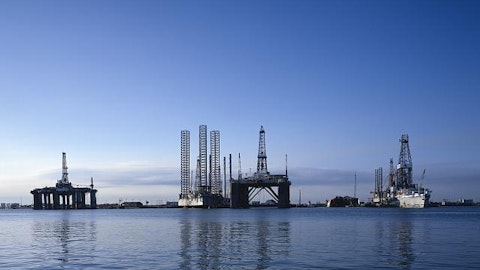So yes, we feel comfortable that there is incremental demand that will take those attractive assets into the market over time.
Eddie Kim: Got it. Got it. Great. Thank you both for all that color. I’ll turn it back.
Operator: Our next question today will come from Kurt Hallead with Benchmark. Please go ahead.
Kurt Hallead: Hey, good morning.
Anton Dibowitz: Morning, Kurt.
Matt Lyne: Good morning, Kurt.
Kurt Hallead: I want to really appreciate you putting into context the total contract value relative to day rate. So in that context, right, one of your larger competitors made a comment that they are being violent opposition to 500K per day kind of day rate dynamics, right. But taking that into bigger context right, what is the dynamic at play currently, with respect to the operators understanding there’s a constrained supply and marrying that up with their project needs, say in ‘24, ‘25 and understanding that no matter how they shake it out, they are going to have to pay more for what’s coming down the pipe?
Anton Dibowitz: I’ll let Matt start.
Matt Lyne: Thanks. So, I mean, we feel really good about where the market sits today and the longevity of the cycle. So I guess, if we look at a couple of the supply metrics to kind of lead us down that path, which will directly relate to continued improvement in the day rate, lead times for tendering for contracts are increasing. And we’re also seeing, as you were pointing out, customers increasing duration by connecting their programs to make it more attractive. And why would they be doing that would be, if they see potential or they see supply decreasing, which incentivizes them to pick up rigs for longer to ensure they have the assets they need to drill. Utilization is increasing, which is obviously resulting in a reduction in supply. And so looking at these main factors from a supply side metrics, it paints a positive picture on the direction of the market.
Anton Dibowitz: I mean what I’ll say, I mean I don’t know about violent disagreement, but no operator wants to pay more for a rig than they have to, and we certainly don’t want to put rigs to work for a dollar less than we can achieve for it. So it comes down to simple economics and supply and demand. And day rates seldom move in a nice clean parabola like you did in math class. As the supply demand picture continues to tighten and incremental demand comes to the market, we have more commercial leverage, and day rates as we have seen, will continue to trend and move up. So what people’s feelings about where they want rates to be are kind of neither here nor there in the grand scheme of things. If people want rigs and the demand continues, the supply continues to tighten and demand continues to increase, which is what we see happening, going into a sustained cycle, then rates will continue to move upwards.
Kurt Hallead: All right. Okay. Great. I appreciate that. Now, my follow-up is you’ve targeted $200 million of share repurchase for 2024. What’s your general sense of what that share repurchase target could be for 20 – to-date? Earmark ’23, what are you earmarking for ‘24?
Anton Dibowitz: Yeah. So, thanks Kurt. One, we think we’re really demonstrating our commitment to returning capital to shareholders. As you know, we repurchase 171 million shares year-to-date, that’s about 3.5% of our outstanding shares, outstanding. We’re on track to execute on that $200 million target this year. We’re going to provide kind of more detailed perspective on ’24, return-to-capital plans on the fourth quarter call. But I want to reiterate what Anton mentioned. Our philosophy around return-to-capital is simple. And when this business is generating meaningful and sustained free cash flow, we’re going to return it all to shareholders, unless we’ve got a more value-creative or better use for it. As we look forward, that’s going to include a dividend. We’ll flex with share repurchases, and we’ll even look at special dividends if we got a significant liquidity event, because as we said, this team is dedicated to capital return to shareholders.


